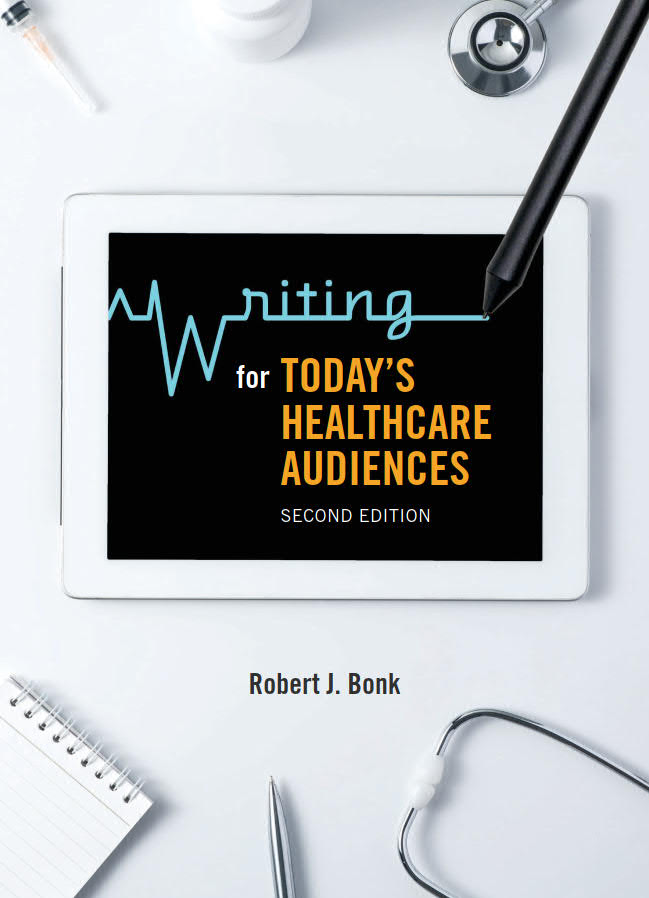This reorganized and updated edition of Writing for Today’s Healthcare Audiences provides new digital supports for students and course instructors.
Designed primarily for students seeking careers in healthcare communication, this book also serves as a useful guide for nascent practitioners. Healthcare writing audiences are diversifying, from traditional physicians and patients to administrators in government and insurance groups and to technical practitioners in a widening range of fields. Writing for these increasingly diverse healthcare audiences is the focus of this book, which has just enough theory to lay groundwork, plentiful examples to illustrate how theory is practiced, summaries that highlight key points, and realistic practice exercises.
The second edition has been reorganized and expanded; new examples throughout refer to the special challenges of healthcare writing in a pandemic. A new companion website for students and general readers provides larger-scale examples by audience, more details on the review and revision processes, and communications skills toolkits; a separate site provides support for instructors planning courses around the book.
Comments
Praise for the first edition
“Robert J. Bonk, the noted authority on writing in the pharmaceutical industry, provides highly useful and sensible coverage of what writers need to know to craft texts within a range of healthcare professions. In concise chapters that make good use of sample documents from many medical contexts, Bonk relies on a solid rhetorical underpinning to encourage writers to be alert to the importance of purpose, audience, and genre in designing medical documents. He covers the practicalities of researching and writing from medical sources, and he offers advice on designing both documents and their accompanying visuals. Bonk’s book should prove popular on many campuses in the growing number of undergraduate courses in healthcare communication.” — Stephen A. Bernhardt, University of Delaware (retired)
“I particularly value Bonk’s attention to the different kinds of potential audiences for healthcare information, the purposes the writing might need to serve, and the ethics involved in presenting such material. Putting ethics right up front, then showing how those ethics apply (even at the beginning of the process when you are selecting sources of information), is an essential part of becoming an effective healthcare writer. This book is also notable for how well it integrates the mechanics of clear communication with real-world examples of texts healthcare writers need to produce.” — Lili Fox Vélez, Scientific Writer and Editor
List of Figures and Tables
Acknowledgments (1st and 2nd Editions)
Preface (1st and 2nd Editions)
PART I: BASICS OF HEALTHCARE COMMUNICATION
- Chapter 1: Preliminaries of Healthcare Writing
- Chapter Objectives
- Writers Now Thinking as Readers
- Overview of the Writing Process
- Inputs and Outputs of Healthcare Writing
- Typical Documents for Healthcare Writers
- Chapter Summary
- Exercises
- Private Practice
- Teamwork Time
- Media Matters
- References
- Chapter 2: Ethical and Legal Responsibilities
- Chapter Objectives
- Ethical Responsibilities of Healthcare Writers
- Social Contract of Professionals
- Ethics, Respect, and Sensitivity
- Healthcare Writers as Advocates
- Legal Responsibilities of Healthcare Writers
- Governmental Regulations
- Confidentiality and Informed Consent
- Copyright and Fair Use
- Evolving Responsibilities as Professionals
- Chapter Summary
- Exercises
- Private Practice
- Teamwork Time
- Media Matters
- References
- Chapter 3: Preparation for Collaboration
- Chapter Objectives
- Collaborative Nature of Healthcare Writing
- Organizational Techniques for Teamwork
- Interpersonal Communication in Healthcare
- Team Scheduling for Writing Projects
- Chapter Summary
- Exercises
- Private Practice
- Teamwork Time
- Media Matters
- References
PART II: STRATEGIES FOR HEALTHCARE AUDIENCES
- Chapter 4: Audiences of Healthcare Information
- Chapter Objectives
- Primary and Secondary Audiences
- Categorization by Knowledge Level
- Writing Techniques for Audience Groups
- Layperson-Focused Example
- Administrator-Focused Example
- Practitioner-Focused Example
- Researcher-Focused Example
- Focus on Non-Researcher Audiences
- Chapter Summary
- Exercises
- Private Practice
- Teamwork Time
- Media Matters
- References
- Chapter 5: Simple Strategies for Basic Situations
- Chapter Objectives
- Audience, Purpose, and Context
- Input Conditions into Output Parameters
- Simple Strategies for Simple Situations
- Spatiality
- Chronology
- Specificity
- Importance
- Advanced Variations on Simple Strategies
- Chapter Summary
- Exercises
- Private Practice
- Teamwork Time
- Media Matters
- References
- Chapter 6: Techniques with Complex Strategies
- Chapter Objectives
- Complex Strategies for Complex Situations
- Problem, Method, Solution
- Classification and Partition
- Comparison and Contrast
- Additional Structural Techniques
- Nesting of Strategies
- Signposting for Guidance
- Chapter Summary
- Exercises
- Private Practice
- Teamwork Time
- Media Matters
- References
- Chapter 7: Generalist Background of Laypersons
- Chapter Objectives
- Strategies for Laypersons
- Analysis of the Composite Layperson
- Constraints of Health Literacy
- Plain-Language Strategies for Laypersons
- Document Examples for Laypersons
- Educational Materials for Laypersons
- Web-Based Information for Laypersons
- Chapter Summary
- Exercises
- Private Practice
- Teamwork Time
- Media Matters
- References
- Chapter 8: Managerial Focus of Administrators
- Chapter Objectives
- Burgeoning Role of Healthcare Administrators
- Establishing the Administrator Focus
- Document Examples for Administrators
- Proposal Requirements for Financial Grants
- Electronic Referrals for Coverage
- Summarized Details for Executives
- Chapter Summary
- Exercises
- Private Practice
- Teamwork Time
- Media Matters
- References
- Chapter 9: Scientific Duality of Practitioners
- Chapter Objectives
- Duality of the Practitioner Audience
- Respecting Scientific Knowledge
- Tailoring for Application
- Techniques for Practitioner Audiences
- Strategies that Balance Duality of Roles
- Mechanics that Facilitate Practical Use
- Document Examples for Practitioners
- Diagnostic Overview of Angina Pectoris
- Protocol Procedures for Clinical Trial
- Training Materials for Public Health
- Chapter Summary
- Exercises
- Private Practice
- Teamwork Time
- Media Matters
- References
- Chapter 10: Publication Materials for Researchers
- Chapter Objectives
- Publication Process for Researchers
- Fine-Tuning the Research Question
- Developing the Research Narrative
- Selecting the Research Techniques
- Common Structures for Publications
- IMRAD Structure of Journal Articles
- Reviews and Annotated Bibliographies
- Chapter Summary
- Exercises
- Private Practice
- Teamwork Time
- Media Matters
- References
PART III: TECHNIQUES WITH HEALTHCARE WRITING
- Chapter 11: Reliable Sources of Information
- Chapter Objectives
- Accessing and Assessing Healthcare Sources
- Traditional Sources in Hard-Copy Format
- Expansive Sources in Electronic Format
- Effective Selection of Search Engines
- Substantiation of Document Content
- Direct and Indirect Formats for Citations
- Chapter Summary
- Exercises
- Private Practice
- Teamwork Time
- Media Matters
- References
- Chapter 12: Writing Mechanics for Healthcare
- Chapter Objectives
- Power of Writing Mechanics
- Building Blocks of Syntax
- Phrases vs. Clauses
- Independent vs. Dependent Clauses
- Hierarchy of Sentence Structure
- Conjunctions and Punctuation
- Avoidable Problems with Syntax
- Restrictive Sense of Relative Clauses
- Misplaced and Meaningless Phrases
- Active, Passive, and Nominalized Verbs
- Pronouns, Expletives, and Other Foibles
- Chapter Summary
- Exercises
- Private Practice
- Teamwork Time
- Media Matters
- References
- Chapter 13: Classical Rhetoric of Argumentation
- Chapter Objectives
- Classical Rhetoric for Persuasion
- Induction and Deduction
- Cause and Effect
- Chapter Summary
- Exercises
- Private Practice
- Teamwork Time
- Media Matters
- References
- Chapter 14: Evidence as Visual Representations
- Chapter Objectives
- Evidence Built with Graphics
- Tables for Data Compilation
- Figures for Data Portrayals
- Line Graphs
- Column Graphs
- Pie Charts
- Other Visuals
- Integration of Visuals into Text
- Additional Notes on Visuals
- Chapter Summary
- Exercises
- Private Practice
- Teamwork Time
- Media Matters
- References
- Chapter 15: Predictions for Healthcare Writing
- Chapter Objectives
- Predicting Trends in Healthcare
- Innovations in Health Technology
- Personalized Therapy by Precision Medicine
- Remote-Access Care through Digital Devices
- Machine Learning for Deep-Data Application
- Equitable Provision of Healthcare
- Resilience of Healthcare Writers
- Chapter Summary
- Exercises
- Private Practice
- Teamwork Time
- Media Matters
- References
Index
Robert J. Bonk is a retired Professor of Professional Writing and Director of Professional Writing Programs at Widener University.
A new companion website for students and general readers provides larger-scale examples by audience, more details on the review and revision processes, and communications skills toolkits.
Writing for Today’s Healthcare Audiences – Second Edition is accompanied by an instructor resource website. The site includes syllabus variations, sample assignments, and document critiques. Please contact your Broadview representative for an access code. If you’re unsure of who your Broadview representative is, please contact publishersreps@broadviewpress.com.










